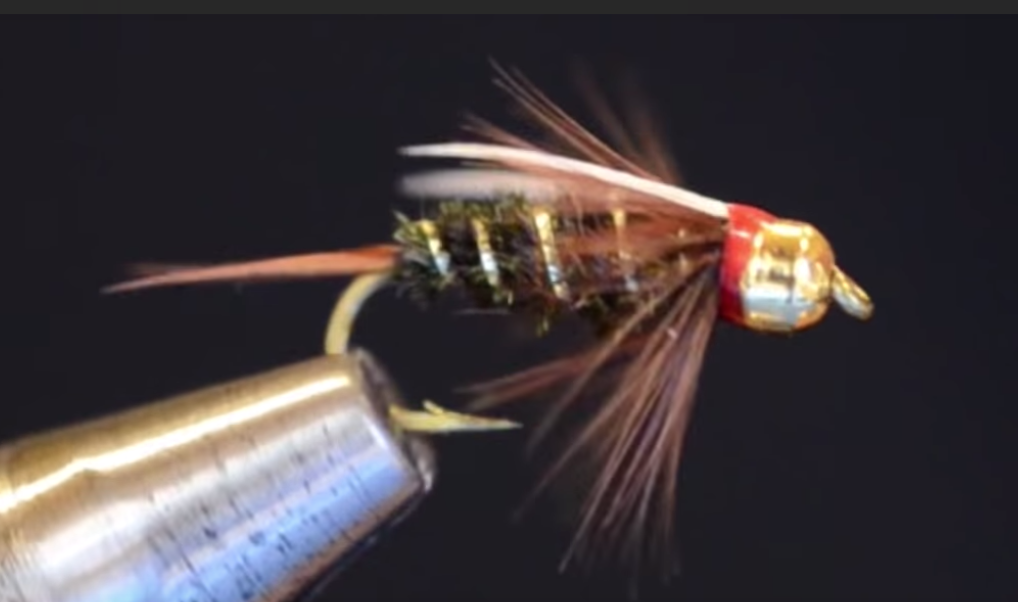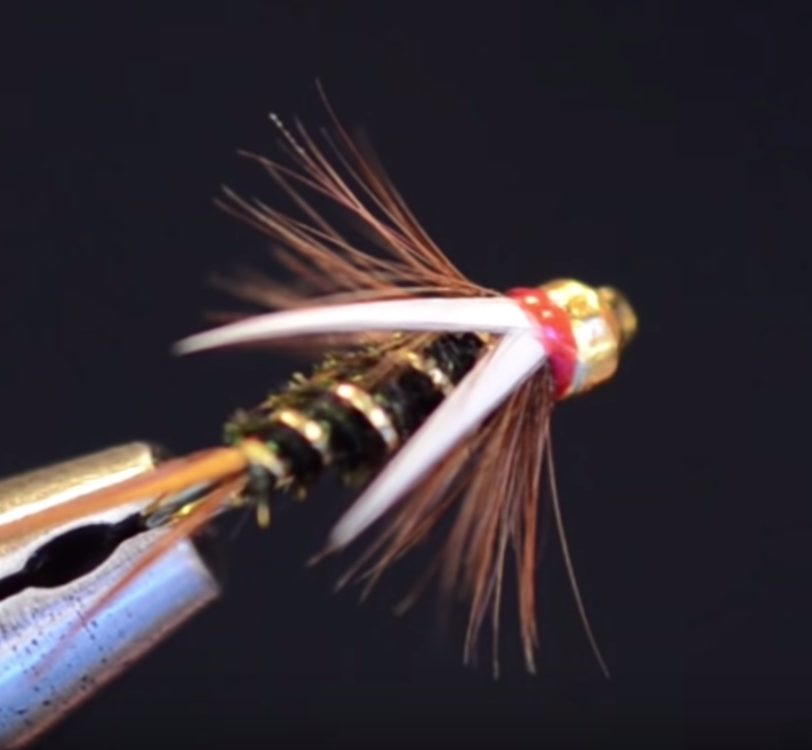Montée par Charlie's Fly Box
Matériaux:
Hook: #4-18 TMC 5262
Thread: Black or Red Veevus 14/0.
Bead: Brass or tungsten (tungsten beads are much heavier than brass, but also more expensive), generally in gold but the color is just a matter of personal preference. The size of the bead is also open to your own personal interpretation, but it can get a little confusing. I have listed a recommended bead to hook size chart below. Incidentally, when tying with a bead you still need to leave an eye length (index point) of space behind the bead so you have room to properly tie off the fly. The index point still exists; it's just behind the bead, rather than the eye.
Weight: .015 Lead Wire
Tails: Brown goose biots, tied opposed.
Rib: Small gold oval tinsel
Body: Peacock herl, dyed if you like
Hackle: Mottled brown hen saddle for flies to #12, hen neck for #14s and smaller
Horns: White goose biots, tied flat over the body.
Notes de l'auteur: The Prince Nymph was developed by Doug Prince in the thirties and in the past fifteen years or so has become a 'go-to' pattern for many anglers across the country. The addition of a brass or tungsten bead has made this fly even more popular and effective. The original fly was known as a Brown Forked Tail but has morphed into what I show here and is commonly accepted as a Prince Nymph today. I tie the Prince (and any other fly with a bead) with lead wire shoved into the bead to add weight, hold the bead in place and center it on the hook. I find the material selection to be very important when tying the Prince. Starting with the biot tails, I select biots from nearer to the tip of the feather, as they tend to be a thinner and are easier to tie in than the biots at the base of the quill, which are wider and hard to tie along the sides of the hook. I also look for biots that have a good degree of natural curve to them to assist in the split tail look. Straight biots can be tied in correctly and still not look right, so look for biots with some curve. I find that bushy, full peacock herl really lends itself well to this fly. Strung peacock is fine as well as herls from the eyed quill as long as they are full fibered. I have been using a lot of dyed peacock for my Princes in bright green, purple and red and find it adds a nice, subtle touch of color on the finished fly. For big Princes (#12 and bigger) I often use hen saddle feathers for the collar but find that on smaller flies a genetic hen neck is necessary to get the proper size. Finally, for the white biot 'horns' at the head of the fly, I use the wider biots at the base of the feather as in this instance their width helps to hold them in place as you tie them down and adds durability. I would be hard pressed to say exactly what the Prince imitates, but if I had to hazard a guess I would have to say a stonefly nymph. The biot tails are what lead me this way, but I've seen this fly work under so many different hatch conditions, from mayflies to caddis, that I think I would be safer to lump it into the attractor nymph category. Traduction souhaitée?
C’est une mouche passe-partout.
Noter ci-après le tableau de correspondance entre la taille de la bille et celle de l’hameçon. Important. Ceci veut dire qu’en fonction du courant et de la profondeur de la rivière certains modèles trop petits et trop peu lestés ne pourront pas être utilisés efficacement car ils n’atteindront pas le poste souhaité. C’est la raison pour laquelle, dans certains montages, on voit de l’ajout de fil de plomb aux billes de tungstène ou plusieurs billes de tungstène. On ne peut pas toujours gagner en profondeur en lançant la mouche plus amont. ceci est vrai pour des postes très courts en torrent de montagne, il faut que la mouche soit en action de pêche tout de suite. C’est le cas par exemple pour pêcher la cascade à la tombée d’un gros caillou. Une des réponses au lestage se situe dans l’ajout de plusieurs billes de même taille ou de taille différentes, tout en respectant le tableau des correspondances entre la taille de la bille et celle de l’hameçon. Voir l’exemple de la Two Bit Stone.
Noter que pour consolider le herl de paon qui est fragile on emploie un tinsel en enroulement du corps. Ce pourrait être du cuivre ou de l’holographique. Le fil de couleur rouge sert de spot ayant un pouvoir d’attraction.



